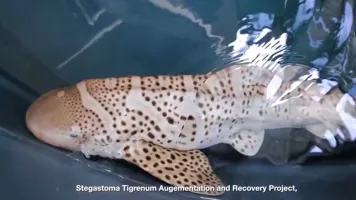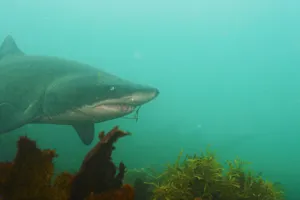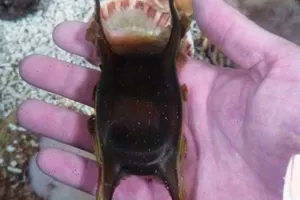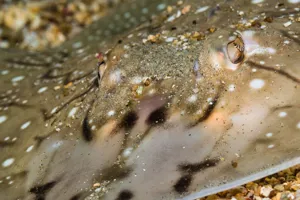How we're helping sharks & rays
At SEA LIFE, we’re passionate about protecting the ocean’s most iconic and misunderstood creatures—sharks and rays. As apex predators, sharks play a vital role in maintaining healthy marine ecosystems, and we support their survival through global breeding programmes, rescue efforts, and cutting-edge research. Meanwhile, with many skate and ray species facing serious threats in the wild, our teams are working hard to better understand their populations and inspire action through public education and conservation initiatives.

SEA LIFE Zebra Shark recovery project
Have you heard about the world's first re-wilding of an endangered shark species? It's called the 'StAR Project,' and SEA LIFE Sydney Aquarium is right in the thick of it. The StAR Project, led by ReShark, is a multi-national, collaborative initiative aiming to establish genetically diverse, self-sustaining populations of zebra sharks in the Indo-West Pacific to benefit local populations and support healthy marine ecosystems. As a project partner, SEA LIFE Sydney Aquarium has contributed valuable breeding, egg and pup data, established shipping and handling techniques, and provided viable eggs to the StAR hatcheries in Raja Ampat.

Sand Tiger Shark Rescues
In Australia, SEA LIFE Sydney is actively involved in rescuing critically endangered grey nurse sharks (also known as sand tiger sharks) that become entangled in fishing gear. The project includes a team of skilled divers who have successfully freed five sharks so far. These sharks are tracked individually using their unique spot patterns. The initiative also focuses on building positive relationships with recreational fishers and promoting community-based conservation around Sydney Harbor.

UK Native Ray Research Project
SEA LIFE has been exploring the UK coastline using underwater visual surveys to uncover the hidden lives of native skates and rays. With around 22 species in UK waters, we still know so little - especially about where their young grow and develop. Since May 2023, our team has been studying a newly identified nursery site for Raja microocellata, the small-eyed skate. This site is now officially recognised as an Important Shark and Ray Area (ISRA), helping pave the way for future protection and research.

SAFE Program for Sharks & Rays
The Saving Animal From Extinction (SAFE) program, led by the Association of Zoos and Aquariums (AZA), harnesses the collective expertise of zoo and aquarium members to prevent species extinction. SEA LIFE has been actively involved in the SAFE Sharks and Rays project since its inception, supporting both in-house animal care and wild research. Through efforts like the International Elasmobranch Census and leadership on the SAFE Animal Care Manual Project, SEA LIFE contributes to global knowledge-sharing and the development of species-specific care guidelines to enhance conservation outcomes.

Sawfish Care in Asia & Australia
SEA LIFE Sydney and SEA LIFE Bangkok, in collaboration with the SEA LIFE Trust and Sharks and Rays Australia, are championing the conservation of the critically endangered sawfish. With four of the five known species still surviving in Northern Australia, the region is considered their final stronghold.
Threats to sawfish include habitat destruction and illegal fishing. In 2019, two satellite tags were deployed to monitor their movements, and educational resources have been developed to raise awareness and encourage conservation action across the region.

Great Eggcase Hunt
Since 2003, SEA LIFE has supported the Shark Trust’s Great Eggcase Hunt, encouraging beachgoers to find and report shark, skate, and ray egg cases known as mermaid’s purses. These leathery pouches provide vital clues about where these species breed. Over 100,000 eggcases have been recorded, helping to map key breeding grounds and identify areas in need of protection. In 2020, SEA LIFE and the Shark Trust expanded the initiative globally by developing new identification and recording tools for use in other regions.

European Undulate Ray Breeding
SEA LIFE has led a European breeding program for the undulate ray (Raja undulata) since 2011. Native to waters from southern UK to southern Portugal, this species faced a dramatic population decline, leading to its Endangered status and protection from commercial fishing in 2009. By 2015, numbers had improved enough for it to be reclassified as ‘Near Threatened’.
The breeding program focuses on careful pairing of adults, juvenile rearing, and maintaining genetic diversity. SEA LIFE also collaborates with Manchester University and Manchester Metropolitan University on genetic research, including the development of a harmless DNA sampling method using skin mucus. This technique, now used for other shark and ray species, supports the study of wild populations many of which show limited movement and mixing, raising concerns about genetic isolation.

Our latest news
Dive in and discover our latest news, stories and fun facts from all around the globe!
Dive in